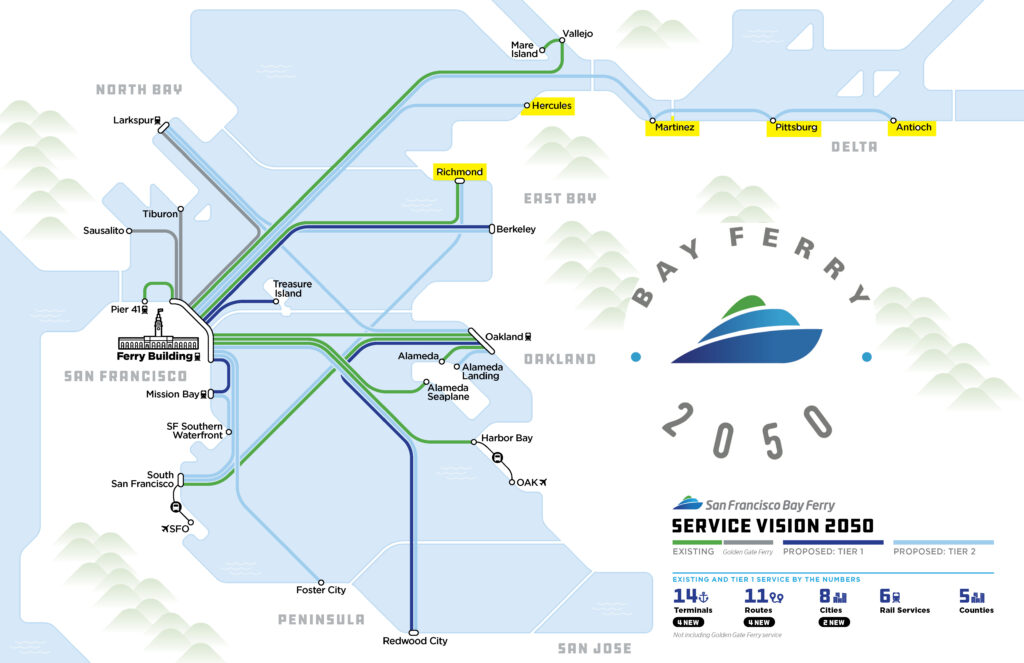WETA includes Antioch ferry stop in 2050 Vision

“A Vision for Water-Based Transportation and Emergency Response on the San Francisco Bay”
By Allen D. Payton
The Bay Area’s Water Emergency Transportation Authority (WETA) board adopted the 2050 Service Vision and Expansion Policy during its meeting on Thursday, May 9 and the plan includes a future, possible station for Antioch, as well as one each in Pittsburg, Martinez and Hercules. Also included is an additional route for the existing terminal in Richmond, which currently offers WETA’s only ferry service in Contra Costa County.
The plan includes two tiers, with the four additional Contra Costa terminals in Tier 2 which will be added based on demand and current, technological barriers to service. The Vision includes one route between the San Francisco Ferry Building to the Hercules terminal and a separate route to and from the Antioch, Pittsburg and Martinez terminals.
The Vision explains that first, “WETA will enhance existing route frequency to continue growing markets for all-day service.” Then, “WETA will expand by implementing the Tier 1 projects from the map including regional priority projects such as those included in regional plans – including Mission Bay and Treasure Island to the San Francisco Ferry Building, Berkeley to San Francisco, and Oakland to Redwood City.”
That will be followed by WETA exploring “development of Tier 2 projects from the map to further expand the reach of the ferry system as market demand matures and technologies evolve to overcome current barriers to operating service.”
In the plan, “WETA will provide at minimum three types of service on the ferry network: Local service consisting of short distance trips connecting dense urban hubs; Regional service consisting of medium and long-distance trips connecting activity centers; and Special Event service to major venues with existing terminals.”
In addition, “WETA will electrify the ferry system to reduce greenhouse gas emissions.”
According to their website, “Water transit is a vital part of life in the San Francisco Bay Area. WETA has been developing a shared vision of the San Francisco Bay Area ferry system in 2050, including the level of service and extent of WETA ferry operations and emergency response.
This ‘Service Vision’ informs how WETA operates in the future and what changes will need to be made to get there. The vision will serve as the foundation of WETA’s Business Plan, which will present the specific strategies and actions required to achieve the 2050 Service Vision. Strategies and goals are divided across six Focus Areas.
This service visioning effort is a unique opportunity to re-imagine water transit and address emerging priorities concerning the environment, equity, economic development, emergency response and quality of life throughout the Bay Area.”
According to the staff report for the agenda item #11, the plan was “developed to define a long-term service vision based on input from agency stakeholders, the public, and other parties with an interest in the future of the agency. The goal of this project is to create clear direction for the agency and its staff concerning future expansion efforts, prioritize the use of limited funds, identify resource needs, and help build a broad coalition to advocate for future investment in the regional ferry network. The WETA Board received a presentation on a draft Policy at its last meeting in April 2024. Following that meeting, staff incorporated comments from Directors into the final 2050 Service Vision and Expansion Policy—including more detailed information about emergency response and first/last mile connections.
During an initial stakeholder and public outreach effort in 2021, staff identified six focus areas
for consideration in the Business Plan. These include:
1. Regional Ferry Network
2. Emergency Response
3. Environmental Stewardship
4. Community Connections
5. Organizational Capacity
6. Financial Capacity
At Business Plan Workshop #1 held in August 2022, the Board identified a set of network expansion concepts for consideration in defining a 2050 Service Vision. Staff undertook a technical evaluation of these concepts and conducted broad stakeholder and public engagement to create a proposal to develop a draft 2050 Service Vision that was presented to the Board during Workshop #2 in April 2023.
Upon receiving direction from the Board to look more broadly at opportunities to expand the ferry network, staff worked with its consultant team to incorporate this feedback into an updated draft 2050 Service Vision and set of feasibility criteria for future expansion projects.
The draft service vision and feasibility criteria were refined upon review with key project stakeholders, the Community and Business Advisory Groups, and the WETA Business Plan Subcommittee. A consistent source of feedback during the outreach process was support for a WETA pilot program to test the feasibility of new technologies and emerging markets. The product of this process is the final 2050 Service Vision and Expansion Policy.”
The Vision also includes Terminal Rehabilitation & Replacement, improvements to Terminal Access, encouraging Transit-Supportive Land Uses in close proximity to eachcandidate ferry terminal, and Emergency Response. “WETA serves as the coordinator of water-based emergency response activities in the Bay Area in the event of a major disaster or disruptive event. In this capacity, WETA will work closely with the California Office of Emergency Services and/or the United States Coast Guard and will be directed to perform activities coordinated on a regional and state-wide basis. These include deploying WETA’s fleet resources to evacuate dangerous areas, to move first responders, and to deliver needed supplies. WETA will coordinate with other regional maritime partners to add to this fleet response, and terminal facilities must have sufficient capacity and facilities to accommodate these partner vessels. All new expansion terminals must be designed and built to Essential Facilities Standards. Emergency service to individual terminals will be guided based on state and regional direction.”
In addition to Thursday’s meeting, WETA held a public Board of Directors workshop on the 2050 Service Vision in April. The service vision evaluation memo and presentation slides are available, here:
Here’s the public survey summary report, first published in May 2023.
To learn more about the project, visit Bay Ferry 2050 microsite where you can subscribe to updates, share your feedback and more.
the attachments to this post:

WETA Service Vision 2050 Map – CoCoCo

























